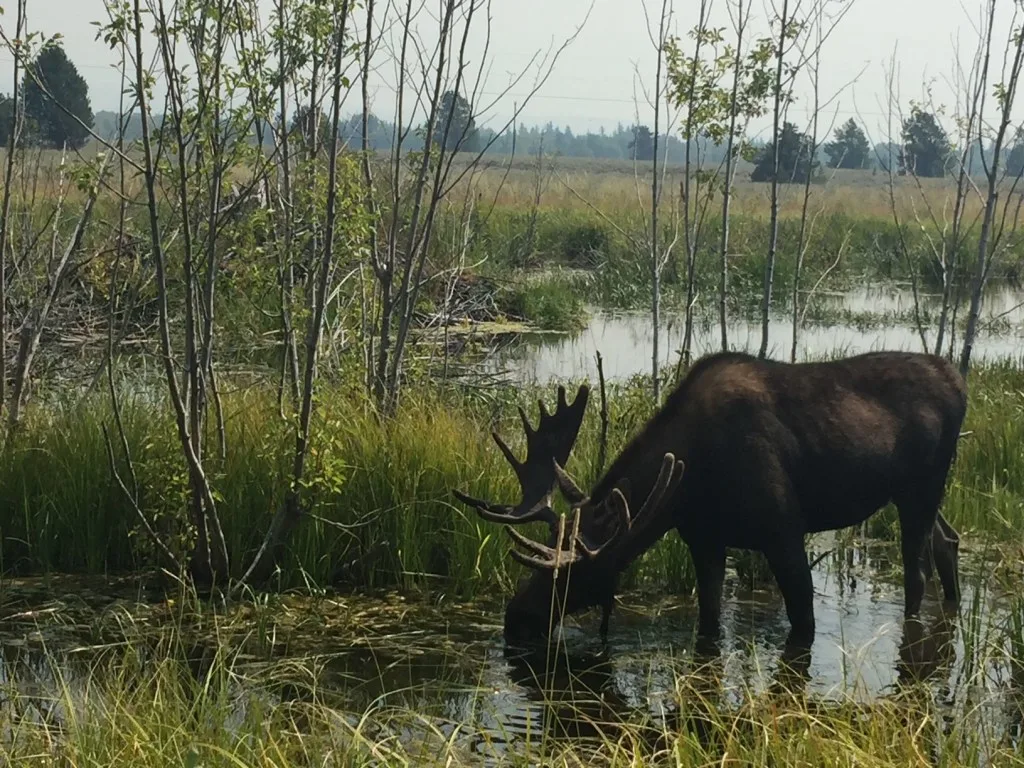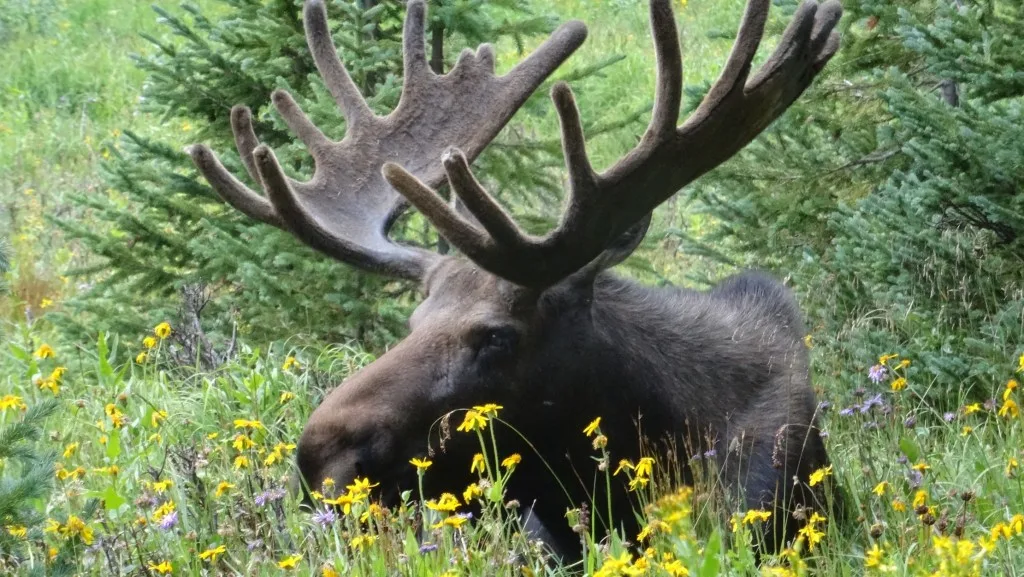Are Moose Dangerous When You’re Camping?
We hear all about bear safety when camping, but are moose dangerous, too?
At an average of 1,000 pounds, a moose can definitely pose a threat. You should certainly be aware of these animals when you’re camping.
With this in mind, we’ve got a few moose facts and safety tips to give you peace of mind.
Let’s learn more!
Are Moose Dangerous When You’re Camping?
There’s no reason to be terrified of moose, but you should be respectful of their power and the potential threat they pose. While they’re not likely to attack, knowing more about them and how to interact with them is always best.
Moose stand at least six feet tall and usually weigh around 1,000 pounds. They’re the largest members of the deer family. You might think their size makes them slow, but you’d be wrong. Moose can run up to 35 mph. They can also use their massive size in defending themselves when necessary.
Males will primarily use their antlers, which can be as big as six feet across, and females can deliver forceful and explosive kicks.
So, are moose dangerous when camping?
They can be, but should you let that stop you from camping? Not a chance. As long as you show respect toward these fantastic creatures, your chances of injuring yourself are much greater than getting injured by a moose.

Do Moose Attack Humans?
Moose are herbivores, meaning they like tree branches, leaves, and even aquatic plants. If a moose attacks you, it’s not because it wants to eat you; it’s because it feels threatened.
However, unlike most animals, moose aren’t afraid of humans, so they won’t run away if approached. Some people take this as an invitation to get closer. But if you encroach upon a moose’s personal space, it may feel threatened and attack.
How to Tell If a Moose Is Going to Attack
Prevention is the best defense. Staying away from moose during certain dangerous seasons is a good way to prevent an attack. Moose are more agitated in the spring when a mother has her calf, during mating season in the fall when males are more confrontational, and in the middle of winter when the food supply may be running short.
If a moose is going to attack, there are warning signs. But moose, like any other wild animal, are unpredictable. That unpredictability is the key takeaway. Whenever possible, stay a safe distance and remember, they’re big and fast animals.
If you find yourself in a situation where you can’t keep that safe distance, watch for these warning signs that a moose may attack.
1) The moose stops what it’s doing and starts paying attention to you. 2) Its ears are back, and it raised its hackles. 3) The moose starts licking its snout. 4) It makes a move toward you or starts to urinate. 5) Its eyes widen, and it throws its head back. All of these could be a warning to you that the moose is getting ready to defend its space.
Read More: Moose aren’t the only wild animals you must be careful of. There’s also bears, bison, bugs oh my! This is what happened when a Yellowstone Bison Attacked Campers.

Tips for Moose Safety While Camping
It’s best to keep a good distance between you and the moose. But if you end up closer than you’d like, here are some ways to stay safe.
Never Feed a Moose
Feeding a moose or any wildlife puts everyone in danger, including the moose. It changes their natural behavior toward food and encourages them to seek out additional food from urban areas.
When wildlife and people interact over food, people can get injured or killed. This ultimately results in the euthanization of the animal to prevent another incident.
Stay Far Away from Moose
Stay far away from moose when camping. This is the number one safety tip when it comes to moose and all wild animals. Moose won’t generally yield to humans or run away, either. If you get too close, they may feel threatened and attack.
Do your best to stay at least 50 feet away. If the moose begins to act differently than when you first saw it, then you’re too close. A moose is most dangerous when it’s surprised.
If you come across one unexpectedly while hiking or just wandering your campsite, you need to be the one to change directions.

Never Get Between a Moose and Its Calf
Like most mammals, a moose will protect her offspring, so never get between a moose and her calf. The best way to prevent this is to simply stay away. If you see a calf, no matter how small and cute, you can bet that Mama isn’t far behind.
Move away slowly and be aware of where Mama might be, so you don’t inadvertently run into her. You know you’re not going to harm her baby, but she doesn’t.
If You’re in Danger from a Moose, Get Behind the Nearest Tree
If a moose charges, run if you must, but get behind the nearest big thing that will put a barrier between you and the moose. Often this is a tree because you’re in the middle of the woods.
But it could be a building or a large fence or whatever structure keeps you away from the moose.
Pro Tip: Want to go camping and enjoy nature, but are worried about the wild animals? These are The Most Dangerous Creatures in the Smoky Mountains that you should look out for!

If a Moose Knocks You Down, Curl Up in a Ball
If you’re unable to get behind something and the moose knocks you down, curl up into a ball. This will protect your head and internal organs. It may still continue attacking, but this is the best way for you to stay protected at that moment.
It may just run away. Stay curled up until you know it’s gone. If the moose is still nearby, it could resume its attack if you start moving around. When you think it has gone, come out of your safety ball slowly to make sure the moose is really gone or at least far enough away for you to get away.
Never Shout or Throw Things at a Dangerous Moose
If you come across a moose while hiking or camping, be respectful. Stay calm, don’t yell, and don’t throw rocks, stones, snowballs, or anything else. Those will only provoke the moose.
You need to back away and change directions. Get behind something big if you think it might attack, but back off slowly. You may shorten your hike if the moose doesn’t want to leave the trail, but at least you won’t shorten your life.
Where Are Moose Found?
Moose are found all across the northern U.S. from Maine to Washington, all of Canada, and in Alaska. They also live in the upper Rocky Mountains, including Colorado, Utah, and Wyoming, with the highest populations in Alaska and Canada.
They thrive in colder climates, including higher altitudes, and love terrain with mountain lakes, streams, and ponds. All of the places that we, as outdoor lovers, also thrive in and love to explore.
Moose Can Be Dangerous if Not Respected
Seeing a moose out in nature in all its glory is a story to tell. These majestic creatures are a wonder to watch, and if you’re lucky enough to catch a glimpse of one, it’s a story you’ll treasure forever.
And while moose can be dangerous, you now know enough to respect them. Keep that story one full of beauty and awe and not one full of broken bones and hospital visits. Have you ever encountered a moose out in the wild?
Discover the Best Free Camping Across the USA
To be honest with you, we hate paying for camping. There are so many free campsites in America (with complete privacy).
You should give it a try!
As a matter of fact, these free campsites are yours. Every time you pay federal taxes, you’re contributing to these lands.
Become a FREE CAMPING INSIDER and join the 100,000 campers who love to score the best site!
We’ll send you the 50 Best Free Campsites in the USA (one per state). Access the list by submitting your email below: